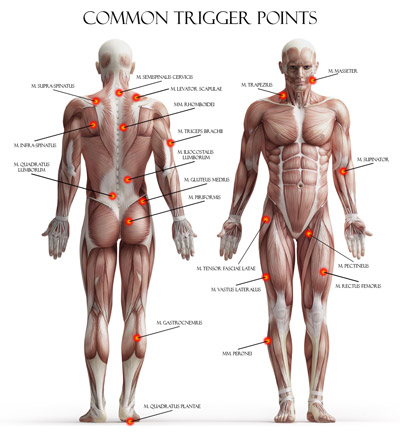Trigger Point Therapy
What is a Trigger Point? (TrP)
A Trigger Point is a firm, painful and tender point in the muscle fiber & fascia. It can be classified as highly sensitive and hyper irritable involving referral pain, a loss of range of motion and may cause weakness to the muscle. There are two types of Trigger Points, active and latent.
-Active TrP’s are always tender and may refer pain and create other sensations as well as having limited range of motion.
-Latent TrP’s will have limited range of motion and stiffness in the muscle without being painful, however, the muscle itself will be weak.
What causes a Trigger Point?
There can be many causes for a TrP to manifest and different people will have different causing factors. Examples would be
-Car Accidents
-Sport Accidents and Injuries
-Acute Illness
-Emotional events such as ( loss of job, divorce, death, illness, etc.)
-Starting a new regimen with new and different demands on the body
-Stress
-Trauma
-Poor diet
-Poor posture
-Lack of sleep
-Dehydration or mineral deficiency
-Imbalances or postural distortions
-Inactivity
Just to name a few!
What does a TrP feel like?
Just like everyone has different causing factors to TrP’s there are also many different ways you may be able to feel them. It all depends on the amount of time it has been active, the location of the TrP and other continual patterns of activity that are aggravating and irritating the muscle. Many people identify their TrP pain to a knot in their muscle. Some people may experience
-Numbness or fatigue
-A superficial dull aching
-A deep aching
-Pins and needles
-Inflammation
-Loss of range of Motion
-Weakness in the muscle tissue
Why do TrP’s hurt?
When over stimulated muscle fibers are chemically prevented from releasing in a contracted state, the muscle fibers are starved from oxygen and the blood flow is reduced. Thus, leading to an accumulation of toxins in the muscle tissue ultimately causing pain.
Because of the toxin build up in the muscle tissue the irritated TrP becomes inflamed and sends out pain signals. Having a high concentration of inflammation will cause sensitivity to pressure and enhance your pain receptors.
How to Treat TrP’s
There are a few options in relieving TrP’s in which I will give a brief description.
-Trigger Point Injection
Usually a local anesthetic is injected into the site of the TrP with a needle.
-Spray and Stretch
The use of a vapocoolant spray to the effected area followed by stretching helps to reduce pain and increase muscle flexion.
-Voluntary Contraction & Release
Actively contract the muscle group effected for about 10 seconds then release the contraction and relax the muscle. Repeat 3-4 times.
-Indirect Techniques
Such as Positional Release Therapy, which involves finding a tender point in the body and moving the body part away from the restricted barrier and towards the position of greatest comfort. The area is then held for a minimum of 90 seconds.
-Accessory Techniques
Will help assist and support all TrP therapies, they include
-Controlled respiration
-Skin rolling
-Heat and Cold Therapy
-Drug Therapy (pain relief, muscle relaxants)
While drug therapy can help significantly with the pain, I highly suggest only using it in extreme conditions if you cannot get the relief you need as the drugs only mask and hide what is going on in your body.
While all these are great ways to help relieve a TrP my favorite way to help release TrP’s are with massage!
PRESSURE RELEASE
Trigger Point Therapy Massage
In a typical TrP Therapy session your Massage Therapist should follow a basic treatment plan which involves
-Pressure release
Pressure is applied gently while gradually increasing as the surrounding tissues soften. This will hurt, however, your therapist should never go past the point of you being able to breathe and relax throughout the treatment. This pressure is held for a minimum of 30 seconds to 1 minute.
-Stripping
Directed along the length of the muscle tissue this technique is used to restore the muscle tissue to normal length by elongating the shortened muscle, helping to decrease muscle tension.
-Stretching
Lengthening muscle fibers and surrounding connective tissues by taking the origin and insertion points of a muscle away from each other; creating elasticity, flexibility and range of motion.
-Recovery or Post Treatment
Your therapist should then give you “homework” or suggestions to help support your session. They may include
-Increased water intake
-Re-patterning exercises (to help support proper movement)
-Hot or Cold Therapy
-Exercises (Including stretches!)
-Appropriate rest
-Nutritional needs
-Environmental stress may be addressed
Benefits of Trigger Point Massage
While dealing with TrP’s are no fun, the highlights are the relief you can experience! Some of the benefits of Massage for TrP’s include
-Decrease in Inflammation
-Increase in range of motion
-Decrease in anxiety
-Reduction of fatique
-Better sleep patterns
-Improved concentration
-Increase in circulation
-More energy
-Stress reduction
-Relaxation



